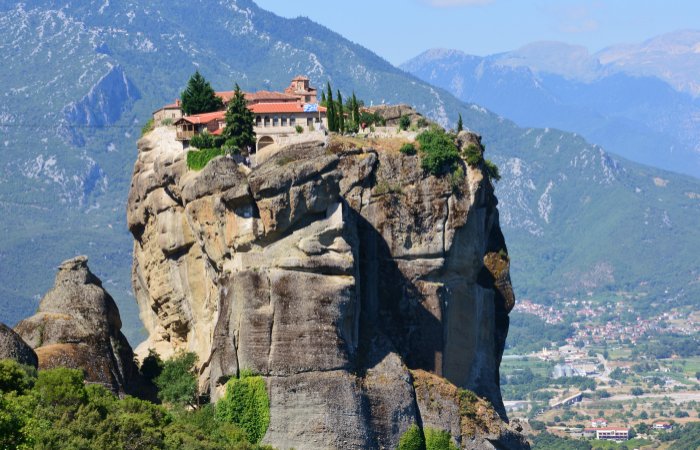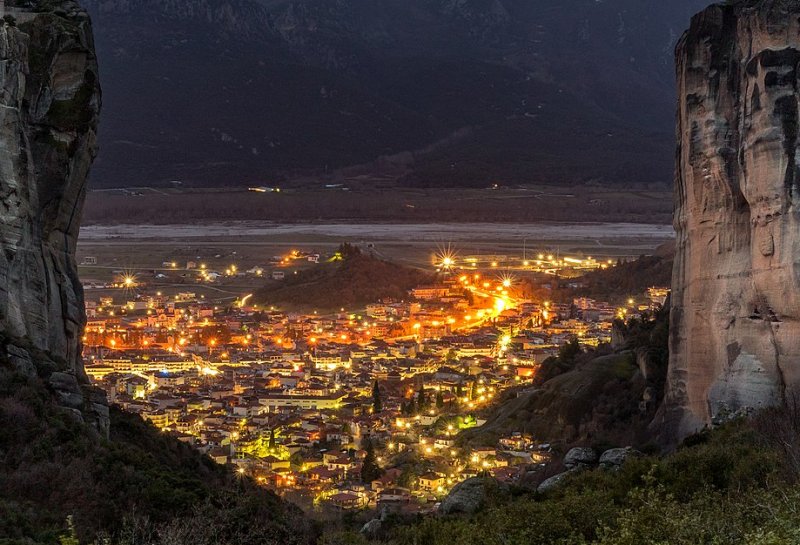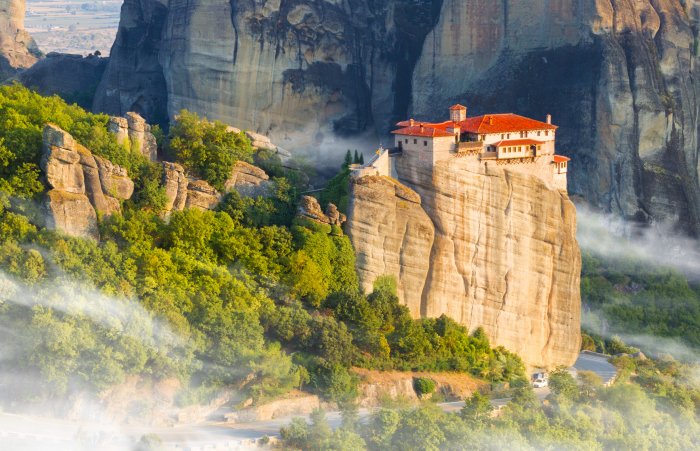Magnificent Meteora And ‘Suspended In The Air’ Greek Monasteries
A. Sutherland - AncientPages.com - Meteora, (means in Greek:" raised from the ground, hanging") and the ancient monasteries built atop the Meteora massif represent a magnificent place that does seem to hang in the sky.
Meteora in Greece. Credit: Adobe Stock - Romy
The Meteora massif, located on the northwest edge of the Thessaly Plain near the Pindus Mountains in central Greece, is a sandstone rock formation rising over 600 meters above sea level. The rock owes its unique appearance to beautiful and strange rock pillars and columns of different shapes.
The process that created the Meteora outcroppings is not precisely explained. Still, it is known that about 60 million years ago, a series of earth movements pushed the seabed upward, forming a high plateau.
The colossal rock pillars emerged in the thick sandstone layer under the weathering processes.
Several hundred years ago, ancient human hands built Greek monasteries on their tops. The monasteries became "meeting places of God with man. Only 6 of the 24 buildings have been preserved in a condition that allows living and visiting.
The monasteries (today, only six) are all in Meteora and date back to the 14th, 15th, and 16th centuries. For nearly a thousand years, spiritual seekers and others isolated from others and self-disciplined individuals have climbed atop the massive high platforms of stone that rise to the clouds.
Meteora by night. Image credit: Argiriskaramouzas - CC BY-SA 4.0
Until today, these people seek the Meteora's high places to link their lives to the divine. It's a sanctuary of harmony and quietness that we can contemplate in the region of Thessaly mentioned in Homer's Odyssey.
The weather conditions often permit us to experience something extraordinary up there, especially when clouds fill the valley of the Pineios River below. The tips of the mountains seem to float on top of the fog like ships in a harbor.
Around Meteora People Probably Lived 50,000 Years Ago
Humans moved around the Meteora massif probably 50,000 years ago, and caves in its vicinity were inhabited uninterruptedly between 50,000 and 5,000 years ago.
The Monastery of Rousanou (in order from background to foreground). The Holy Spirit Rock is on the left side, while Dupiani Rock can be seen in the center, at the middle of the valley. Image source
One of the caves is known as the cave of Theopetra, inhabited by humans 130,000 years ago. It was constructed 23,000 years ago to protect against extreme winds when the planet Earth was experiencing an ice age, and the caves were good shelters. There is also the oldest known example of a built structure at this site - a stone wall that blocked two-thirds of the entrance to the Theopetra cave.
Building the first Orthodox monasteries dates to the 14th century, but persons who lived in seclusion (the Hermits) had already earlier inhabited the caves of Meteora at the end of the 11th century.
For several hundred years, access to monasteries was limited. Until the 1920s, the only way up to the monastery was to use special nets and baskets suspended on ropes for transporting people, food, and materials necessary to construct and repair monasteries.
It took time until steps were built into the rock.
Monks' Life In Meteora Monasteries
Meteora in Greece. Credit: Adobe Stock - Romy
The monks living in the monasteries experienced a period of splendor in the 16th century when Suleiman I (1494 -1566) (known as Suleiman the Magnificent) ruled the Ottoman Empire. Having learned about the monasteries on the high rocks of Meteora, the sultan ordered to deposit of most of the riches looted during the wars. So, the monks lived in 'the Sultan's Treasury' and significantly improved their living conditions, and apparently, they did not oppose the occupation.
The largest monastery of Meteora is 'Megalo Meteor, which is located at a height of 534 meters above sea level) and was constructed in the 14th century
Today, it is reached by one-hundred-fifteen stone steps.
Like other Meteora monasteries, the 'Megalo Meteoro' was also devastated during the Second World War and the German bombing. Recently, the landmark was renovated, and the structure is now added to the historical museum located in the sanctuary's interior. Inside is a monastic Ossuary (or the so-called skull chapel), which contains the bones of all monks living in monasteries.
Written by – A. Sutherland - AncientPages.com Senior Staff Writer
Updated on October 20, 2022
Copyright © AncientPages.com All rights reserved. This material may not be published, broadcast, rewritten or redistributed in whole or part without the express written permission of AncientPages.com
More From Ancient Pages
-
 Locations Of 11 Lost Ancient Cities Revealed On 4,000-Year-Old Artifacts
Archaeology | Nov 15, 2017
Locations Of 11 Lost Ancient Cities Revealed On 4,000-Year-Old Artifacts
Archaeology | Nov 15, 2017 -
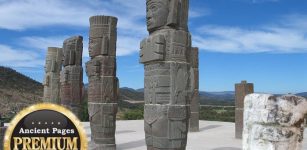 Secret Ancient Knowledge Of The Toltecs Examined
Civilizations | Aug 16, 2019
Secret Ancient Knowledge Of The Toltecs Examined
Civilizations | Aug 16, 2019 -
 Riddle Of The Ancient Sarcophagus And Its Strange Properties – Can Science Solve This Mystery?
Featured Stories | Nov 7, 2019
Riddle Of The Ancient Sarcophagus And Its Strange Properties – Can Science Solve This Mystery?
Featured Stories | Nov 7, 2019 -
 Unexplained Teleportation Cases Of People – Ancient Times – Part 1
Featured Stories | Sep 30, 2019
Unexplained Teleportation Cases Of People – Ancient Times – Part 1
Featured Stories | Sep 30, 2019 -
 Mysterious Melchizedek: ‘King Of Righteousness’ And Heavenly High Priest In Bible And Dead Sea Scrolls
Biblical Mysteries | Sep 2, 2017
Mysterious Melchizedek: ‘King Of Righteousness’ And Heavenly High Priest In Bible And Dead Sea Scrolls
Biblical Mysteries | Sep 2, 2017 -
 On This Day In History: Walpurgis Night Celebration In Northern Europe – On Apr 30
News | Apr 30, 2016
On This Day In History: Walpurgis Night Celebration In Northern Europe – On Apr 30
News | Apr 30, 2016 -
 ‘Be Wise As Serpents And Harmless As Doves’ – The Story Of The Serpent People And Their Guidance
Civilizations | May 7, 2014
‘Be Wise As Serpents And Harmless As Doves’ – The Story Of The Serpent People And Their Guidance
Civilizations | May 7, 2014 -
 Ancient ‘iPhone-Like’ Artifact Discovered At The Russian Atlantis
Archaeology | Sep 10, 2019
Ancient ‘iPhone-Like’ Artifact Discovered At The Russian Atlantis
Archaeology | Sep 10, 2019 -
 Pamola: Mighty Thunderbird In Myths Of Penobscot People Of Maine
Featured Stories | Apr 25, 2019
Pamola: Mighty Thunderbird In Myths Of Penobscot People Of Maine
Featured Stories | Apr 25, 2019 -
 Puzzling Connection Between Native Americans And Lost Northern European Race Could Re-Write History
Civilizations | Apr 14, 2018
Puzzling Connection Between Native Americans And Lost Northern European Race Could Re-Write History
Civilizations | Apr 14, 2018 -
 Roman Ship Cargo And Galley Equipment Discovered Underwater In The Caesarea Harbor
Archaeology | Sep 12, 2023
Roman Ship Cargo And Galley Equipment Discovered Underwater In The Caesarea Harbor
Archaeology | Sep 12, 2023 -
 Ancient Mysteries Of West Virginia: Did Ancient Celts Visit North America Where They Left An Ogham Inscribed Bone Needle With Christian Symbols?
Artifacts | Mar 1, 2017
Ancient Mysteries Of West Virginia: Did Ancient Celts Visit North America Where They Left An Ogham Inscribed Bone Needle With Christian Symbols?
Artifacts | Mar 1, 2017 -
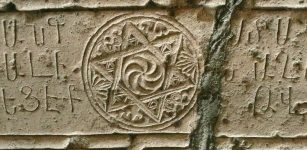 Ancient Iconic Armenian Wheel Of Eternity Depicted Inside A Six Pointed Star
Ancient Symbols | Feb 27, 2017
Ancient Iconic Armenian Wheel Of Eternity Depicted Inside A Six Pointed Star
Ancient Symbols | Feb 27, 2017 -
 Oldest Evidence Of Beer Was Found On A Sumerian Tablet In Mesopotamia
Ancient History Facts | Jan 23, 2016
Oldest Evidence Of Beer Was Found On A Sumerian Tablet In Mesopotamia
Ancient History Facts | Jan 23, 2016 -
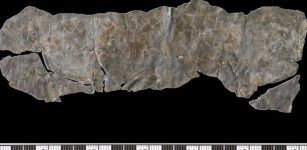 Intriguing Connection Between Ancient Curse Tablets And The Book Of Revelation Discovered
Artifacts | Feb 9, 2023
Intriguing Connection Between Ancient Curse Tablets And The Book Of Revelation Discovered
Artifacts | Feb 9, 2023 -
 Giant Mimir And The Well Of Wisdom In Norse Beliefs
Featured Stories | Apr 11, 2018
Giant Mimir And The Well Of Wisdom In Norse Beliefs
Featured Stories | Apr 11, 2018 -
 Munkholmen: Island With Intriguing Yet Dark And Scary History
Featured Stories | Aug 25, 2023
Munkholmen: Island With Intriguing Yet Dark And Scary History
Featured Stories | Aug 25, 2023 -
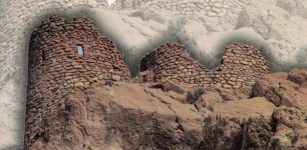 Mythical Temple Of Wingded Warrior God Haldi In The ‘City Of The Raven’
Civilizations | Jul 21, 2016
Mythical Temple Of Wingded Warrior God Haldi In The ‘City Of The Raven’
Civilizations | Jul 21, 2016 -
 Ancient Recycling Technology Modern World Still Hasn’t Invented
Civilizations | May 5, 2018
Ancient Recycling Technology Modern World Still Hasn’t Invented
Civilizations | May 5, 2018 -
 Siberia Had A Major Skull Surgery Center 2,500 Years Ago
Ancient History Facts | Jul 19, 2019
Siberia Had A Major Skull Surgery Center 2,500 Years Ago
Ancient History Facts | Jul 19, 2019

